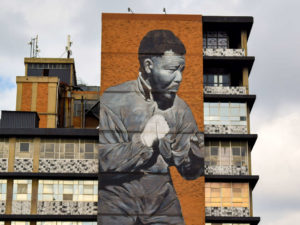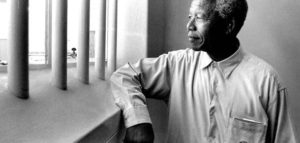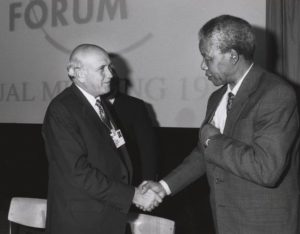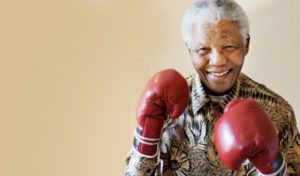100 Years Nelson Mandela
 When Nelson Mandela was born on a stormy day in July 18th 1918 in Mvezo, South Africa, his father gave him the name Rholihaha, which means in the Xhosa language “troublemaker”. Did he have any idea that his youngest son would become Africa’s most important peacemakers?
When Nelson Mandela was born on a stormy day in July 18th 1918 in Mvezo, South Africa, his father gave him the name Rholihaha, which means in the Xhosa language “troublemaker”. Did he have any idea that his youngest son would become Africa’s most important peacemakers?
Mandela’s Education
Nelson Mandela took part in the activities and initiation ceremonies of his local tribe. However, unlike his father Nelson Mandela gained a western education, studying at the University College of Fort Hare and also the University of Witwatersrand. Nelson qualified with a law degree in 1942. That’s why later on he was able to build bridges between the white and the black peoples of South Africa.
Resistance to White Domination
 In Johannesburg, Nelson Mandela came into contact with the African National Congress, the ANC, who called for better working conditions for black people. Nelson Mandela founded the youth league of the ANC together with some of his fellow activists. They ignored the laws of racial segregation. Thousands took part in the actions. In 1956, Nelson Mandela, along with several other members of the ANC were arrested and charged with treason. After a lengthy court case, the defendants were finally acquitted in 1961. The ANC was banned, Mandela’s career was ruined. When in 1960 the Sharpville massacre occured, in which 69 students were shot by the police Nelson Mandela suggested an active armed resistance to the apartheid regime. This led to the formation of Umkhonto we Sizwe, which would act as a guerilla resistance movement. Receiving training in other African countries, Nelson Mandela took part in active sabotage.
In Johannesburg, Nelson Mandela came into contact with the African National Congress, the ANC, who called for better working conditions for black people. Nelson Mandela founded the youth league of the ANC together with some of his fellow activists. They ignored the laws of racial segregation. Thousands took part in the actions. In 1956, Nelson Mandela, along with several other members of the ANC were arrested and charged with treason. After a lengthy court case, the defendants were finally acquitted in 1961. The ANC was banned, Mandela’s career was ruined. When in 1960 the Sharpville massacre occured, in which 69 students were shot by the police Nelson Mandela suggested an active armed resistance to the apartheid regime. This led to the formation of Umkhonto we Sizwe, which would act as a guerilla resistance movement. Receiving training in other African countries, Nelson Mandela took part in active sabotage.
The Move to Armed Struggle
 In 1963, Mandela was again arrested and put on trial for treason. This time the State succeeded in convicting Mandela of plotting to overthrow the government. However, the case received considerable international attention and the apartheid regime of South Africa became under the glare of the international community. Nelson Mandela faced death sentence, but finally he was sentenced to life imprisonment. from 1964 –1981 he was incarcerated at Robben Island Prison, off Cape Town. In prison the conditions were sparse; however, Mandela was with many other political prisoners, and there was a strong bond of friendship which helped to make more bearable the difficult prison conditions. Also, in prison, Nelson Mandela was highly disciplined; he would try and study and take part in exercise every day. He later said these year of incarceration were a period of great learning, even if painful. Mandela also created friendships with some of the guards. Mandela would later say that he felt he was fighting the apartheid system and not individual white people. When South Africa fell into violence in the 1980s and the economy was on the brink of collapse, Nelson Mandela started his policy of reconciliation out of jail.
In 1963, Mandela was again arrested and put on trial for treason. This time the State succeeded in convicting Mandela of plotting to overthrow the government. However, the case received considerable international attention and the apartheid regime of South Africa became under the glare of the international community. Nelson Mandela faced death sentence, but finally he was sentenced to life imprisonment. from 1964 –1981 he was incarcerated at Robben Island Prison, off Cape Town. In prison the conditions were sparse; however, Mandela was with many other political prisoners, and there was a strong bond of friendship which helped to make more bearable the difficult prison conditions. Also, in prison, Nelson Mandela was highly disciplined; he would try and study and take part in exercise every day. He later said these year of incarceration were a period of great learning, even if painful. Mandela also created friendships with some of the guards. Mandela would later say that he felt he was fighting the apartheid system and not individual white people. When South Africa fell into violence in the 1980s and the economy was on the brink of collapse, Nelson Mandela started his policy of reconciliation out of jail.
Mandela’s Policy of Reconciliation
 During his time in prison, Mandela became increasingly well known throughout the world and was symbolic of the struggle against the apartheid regime. His continued imprisonment led to a world-wide pressure for his release. Many countries implemented sanctions on apartheid South Africa. Due to international pressure the apartheid regime increasingly began to negotiate with the ANC and Nelson Mandela in particular. On many occasions, Mandela was offered a conditional freedom. However, he always refused to put the political ideals of the ANC above his own freedom. Nelson Mandela was released on February 11, 1990. The day was a huge event for South Africa and the world. His release was symbolic of the impending end of apartheid. Together with his political rival Frederik Willem de Klerk and the Zulu leader Mangosuthu Buthelezi he developed a democratic constitution. As a brilliant tactician he integrated opponents as well as violent supporters. In April 1994, South Africa had its first full and fair elections. The ANC was elected by a large majority and Nelson Mandela became the first President of the new South Africa. His policy of reconciliation saved South Africa from civil war. He sought to heal the rifts of the past. Nelson Mandela oversaw the formation of the Truth and Reconciliation Committee in which former crimes of apartheid were investigated, but stressing individual forgiveness and helping the nation to look forward. His forgiving attitude gained the respect of the whole South African nation.
During his time in prison, Mandela became increasingly well known throughout the world and was symbolic of the struggle against the apartheid regime. His continued imprisonment led to a world-wide pressure for his release. Many countries implemented sanctions on apartheid South Africa. Due to international pressure the apartheid regime increasingly began to negotiate with the ANC and Nelson Mandela in particular. On many occasions, Mandela was offered a conditional freedom. However, he always refused to put the political ideals of the ANC above his own freedom. Nelson Mandela was released on February 11, 1990. The day was a huge event for South Africa and the world. His release was symbolic of the impending end of apartheid. Together with his political rival Frederik Willem de Klerk and the Zulu leader Mangosuthu Buthelezi he developed a democratic constitution. As a brilliant tactician he integrated opponents as well as violent supporters. In April 1994, South Africa had its first full and fair elections. The ANC was elected by a large majority and Nelson Mandela became the first President of the new South Africa. His policy of reconciliation saved South Africa from civil war. He sought to heal the rifts of the past. Nelson Mandela oversaw the formation of the Truth and Reconciliation Committee in which former crimes of apartheid were investigated, but stressing individual forgiveness and helping the nation to look forward. His forgiving attitude gained the respect of the whole South African nation.
Nelson Mandela and Ubuntu
 Nelson Mandela retired from the Presidency in 1999. He has campaigned to highlight the issue of HIV / AIDS in South Africa. The epidemic has changed the country more than the civil wars before. The number of infected people in the Cape is estimated at 5.5 million, and the AIDS orphans to more than two million. He launched educational campaigns and donated part of his assets to a children’s hospital, schools and orphanages. Shortly before his death, he founded together with Desmond Tutu “The Elders”, a council with internationally experienced politicians who were designed to continue his long walk to freedom. Members include Kofi Annan, his wife Graça Machel, Jimmy Carter, Gro Harlem Brundtland and many others. On December 5, 2013 Nelson died at the age of 95 years in his hometown Qunu.
Nelson Mandela retired from the Presidency in 1999. He has campaigned to highlight the issue of HIV / AIDS in South Africa. The epidemic has changed the country more than the civil wars before. The number of infected people in the Cape is estimated at 5.5 million, and the AIDS orphans to more than two million. He launched educational campaigns and donated part of his assets to a children’s hospital, schools and orphanages. Shortly before his death, he founded together with Desmond Tutu “The Elders”, a council with internationally experienced politicians who were designed to continue his long walk to freedom. Members include Kofi Annan, his wife Graça Machel, Jimmy Carter, Gro Harlem Brundtland and many others. On December 5, 2013 Nelson died at the age of 95 years in his hometown Qunu.
Mandela’s Heritage
 Nelson Mandela is considered the father of a democratic South Africa and widely admired for his ability to bring together a nation, previously divided by apartheid. He is one of the most admired political leaders of Africa for his vision to forgive and forge a new ‘rainbow’ nation. For millions of young peoples today his political heritage is an inspiration.
Nelson Mandela is considered the father of a democratic South Africa and widely admired for his ability to bring together a nation, previously divided by apartheid. He is one of the most admired political leaders of Africa for his vision to forgive and forge a new ‘rainbow’ nation. For millions of young peoples today his political heritage is an inspiration.
“I learned that courage was not the absence of fear, but the triumph over it. The brave man is not he who does not feel afraid, but he who conquers that fear.” Nelson Mandela
Did you know?
Nelson Mandela received 250 awards, including the 1993 Nobel Peace Prize along with F. W. de Klerk for his work in helping to end racial segregation in South Africa.
Watch a short Biopic on Nelson Mandela



